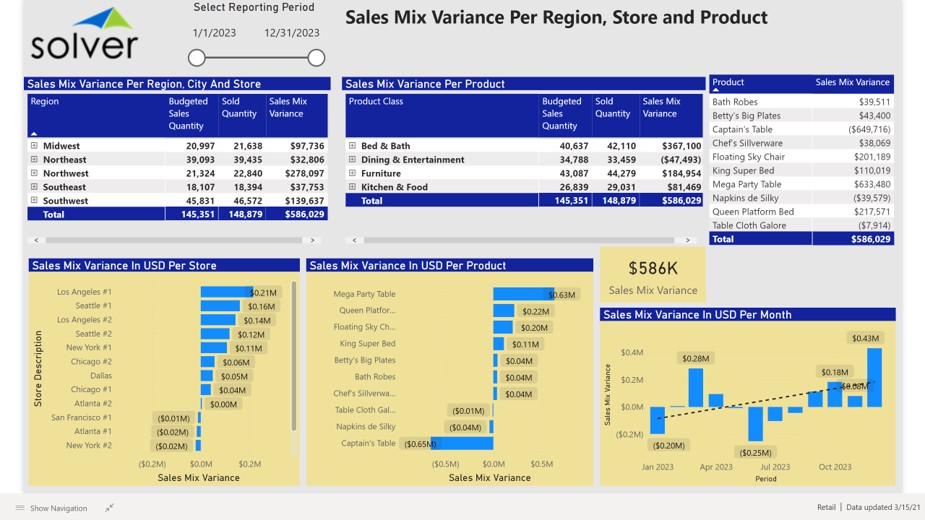Sales Mix Variance Dashboard for Retail Companies
What is a
Sales Mix Variance Dashboard
? Sales Mix Variance Dashboards are considered sales analysis tools and are used by product and regional managers to analyze sales mix across regions, stores, product groups and products. Some of the main functionality in this type of dashboard is that it shows variances in sales mix across six different perspectives: 1) Sales mix variance by region, city and store, 2) Sales mix variance by product group and product, 3) Sales mix variance by store (ranked chart based on variance), 4) Sales mix variance by product (ranked chart based on variance), 5) Sales mix variance monthly trend, and 6) Product list with sales mix variance amount.
The definition of sales mix variance used here is: The variance from the budgeted product sales mix and its impact on the contribution margin. The formula used for this was: Sales Mix Variance = (Actual quantity sold per product - Budgeted quantity sold per product) * Budgeted contribution margin per product. You find an example of this type of dashboard below.
Purpose of
Sales Mix Variance Dashboards Retail organizations use Sales Mix Variance Dashboards to make it easy for managers to see the financial impact of product sales quantity variances in terms of actual versus budgeted sales. When used as part of good business practices in Financial Planning & Analysis (FP&A) and product departments, an organization can improve and speed up its product strategies and increase its sales revenues, and it can reduce the chances that low performers are not getting timely attention.
Sales Mix Variance Dashboard
Example Here is an example of a Sales Mix Variance Dashboard with analysis by region, store, product group and product.
 Example of a Sales Mix Variance Dashboard for Retail CompaniesYou can find hundreds of additional examples
here
Who Uses This Type of
Dashboard
? The typical users of this type of dashboard are: CFOs, analysts, regional managers, store managers, ecommerce managers, price managers, product managers.
Other Reports Often Used in Conjunction with
Sales Mix Variance Dashboards Progressive Financial Planning & Analysis (FP&A) departments sometimes use several different Sales Mix Variance Dashboards, along with financial dashboards, profit & loss reports, sales reports, price and cost reports, sales forecast, annual budgets and other management and control tools.
Where Does the Data for Analysis Originate From? The Actual (historical transactions) data typically comes from enterprise resource planning (ERP) systems like: Microsoft Dynamics 365 (D365) Finance, Microsoft Dynamics 365 Business Central (D365 BC), Microsoft Dynamics AX, Microsoft Dynamics NAV, Microsoft Dynamics GP, Microsoft Dynamics SL, Sage Intacct, Sage 100, Sage 300, Sage 500, Sage X3, SAP Business One, SAP ByDesign, Acumatica, Netsuite and others. In analyses where budgets or forecasts are used, the planning data most often originates from in-house Excel spreadsheet models or from professional corporate performance management (CPM/EPM) solutions.
What Tools are Typically used for Reporting, Planning and Dashboards? Examples of business software used with the data and ERPs mentioned above are:
Example of a Sales Mix Variance Dashboard for Retail CompaniesYou can find hundreds of additional examples
here
Who Uses This Type of
Dashboard
? The typical users of this type of dashboard are: CFOs, analysts, regional managers, store managers, ecommerce managers, price managers, product managers.
Other Reports Often Used in Conjunction with
Sales Mix Variance Dashboards Progressive Financial Planning & Analysis (FP&A) departments sometimes use several different Sales Mix Variance Dashboards, along with financial dashboards, profit & loss reports, sales reports, price and cost reports, sales forecast, annual budgets and other management and control tools.
Where Does the Data for Analysis Originate From? The Actual (historical transactions) data typically comes from enterprise resource planning (ERP) systems like: Microsoft Dynamics 365 (D365) Finance, Microsoft Dynamics 365 Business Central (D365 BC), Microsoft Dynamics AX, Microsoft Dynamics NAV, Microsoft Dynamics GP, Microsoft Dynamics SL, Sage Intacct, Sage 100, Sage 300, Sage 500, Sage X3, SAP Business One, SAP ByDesign, Acumatica, Netsuite and others. In analyses where budgets or forecasts are used, the planning data most often originates from in-house Excel spreadsheet models or from professional corporate performance management (CPM/EPM) solutions.
What Tools are Typically used for Reporting, Planning and Dashboards? Examples of business software used with the data and ERPs mentioned above are:
- Native ERP report writers and query tools
- Spreadsheets (for example Microsoft Excel)
- Corporate Performance Management (CPM) tools (for example Solver)
- Dashboards (for example Microsoft Power BI and Tableau)
Corporate Performance Management (CPM) Cloud Solutions and More Examples
March 16, 2021
TAGS:
Reporting,
Solver,
report writer,
Microsoft,
template,
practice,
Acumatica,
visualization,
Netsuite,
Finance,
planning,
GP,
dashboard,
sales dashboard,
Business Central,
excel,
ax,
forecast,
Budget,
Dynamics 365,
budgeting,
region,
Cloud,
Software,
product,
Tableau,
SAP,
example,
ecommerce,
best,
Sage,
BC,
store,
D365,
NAV,
Intacct,
Variance,
online,
Retail,
CPM,
report,
product sales dashboard,
SL,
Management,
dynamics,
Power BI,
sales mix,
sales mix variance,
LS Retail

